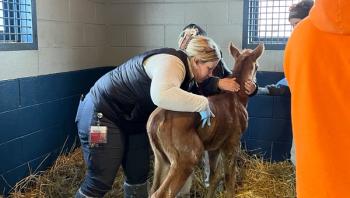
AKC recognizes three new breeds
National Report - A herder, a hunter and an ancient breed are the newest additions to the American Kennel Club's recognized breed list.
NATIONAL REPORT — A herder, a hunter and an ancient breed are the newest additions to the American Kennel Club's (AKC) recognized breed list.
In fact, AKC welcomed three new breeds in 2011—the Entlebucher Mountain Dog, the Norwegian Lundehund and the Xoloitzcuintli—bringing the total number of registered breeds to 170.
Entlebucher Mountain Dog
This breed is a Swiss native and the smallest of the four tri-colored Swiss Mountain Dogs. The medium-sized breed is compact with a short, hard, tricolor coat, AKC says. Primarily a herding and all-purpose dog, "Entles" excel at competitive sports and have high energy and exercise requirements. The National Entlebucher Mountain Dog Association (NEMDA) reports the breed is predisposed to Entlebucher Urinary Syndrome (EUS).
Even though it's rare,"EUS is a disease of the renal/urinary system caused by an underlying genetic anatomical abnormality at the junction of the ureter and bladder," according to NEMDA. "Clinical presentations can range from no clinical signs, occasional leaking of urine, constant dribbling of urine, all the way to renal failure and death."
Norwegian Lundehund
This Spitz breed is considered small and agile with characteristics like six toes on each foot, the ability to close its ears completely and tip its head backward until it touches the backbone. The Norwegian Lundehund originated on remote islands in artic Norway, and AKC says it's the only registered breed whose original purpose was puffin hunting.
The popularity of the Norwegian Lundehund dwindled when puffins became a protected species in the 1800s, AKC notes, but the breed's loyal and playful nature make it a good pet.
One detractor, according to the Norwegian Lundehund Club of America, is the presence of Lundehund Syndrome, which is a collective term for a group of gastrointestinal disorders that include bacterial overgrowth in the small intestine and protein-losing enteropathy (PLE) that causes abnormal protein loss in the intestines.
"To say Lundehund Syndrome is pervasive is an understatement," according to the breed club. "According to research, every Lundehund is affected, though some are asymptomatic."
Veterinarian Nora Berghoff researches Lundehund Syndrome at Texas A&M University and offers free blood and fecal testing to diagnose the disease.
Xolo
The Xoloitzcuintli (pronounced show-low-eats-queen-tlee) or the Xolo is one of the oldest and rarest breeds in the world, dating back to ancient Mexico. In the ancient world, the breed was thought to ward off rheumatism, asthma, toothache, insomnia and evil spirits. The breed is recognized in three sizes—toy, miniature and standard—and can be either hairless or covered in a short, flat coat. AKC says the breed makes an excellent companion.
Xoloitzcuintli Club USA, nor the AKC or Canadian Kennel Club offer clues to genetic health problems in the breed.
AKC also added several new dog breeds to the miscellaneous class for 2011—Bergamasco, Boerboel, Dogo Argentino, Portuguese Pequeno, Peruvian Inca Orchid, Pumi, Sloughi and Wirehard Vizsla.
Newsletter
From exam room tips to practice management insights, get trusted veterinary news delivered straight to your inbox—subscribe to dvm360.




